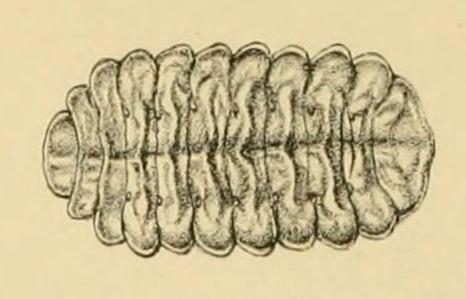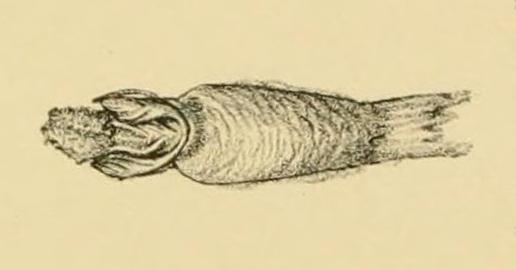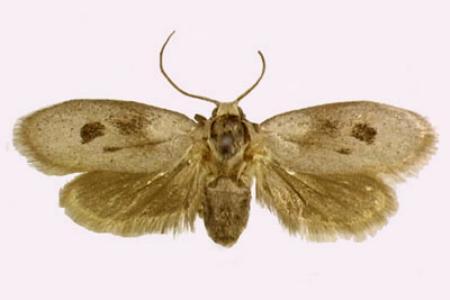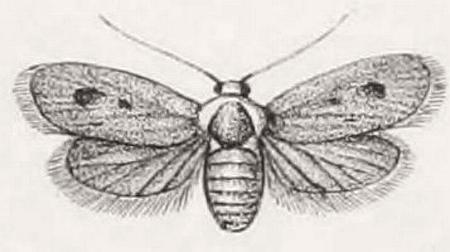
early larva, black and white line drawing by H. Knight,
in Dodds & Meyrick: 'Some remarkable ant-friend Lepidoptera of Queensland',
Transactions of the Entomological Society of London, 1911, Plate XLVIII, fig. 12,
image courtesy of Biodiversity Heritage Library,
digitized by Smithsonian Libraries.
The caterpillars of this species are carnivorous.
The caterpillars are red, flat and segmented, and look like woodlice.
The early instars feed on
Leaf Hoppers
(
CICADELLIDAE ).
The caterpillars then form a first cocoon.
The later instars emerge after a few days, and are taken by
Meat Ants ( Iridomyrmex purpureus,
FORMICIDAE ),
into the Ants' nest, where the caterpillars feed on the ant larvae.
The mature caterpillars leave the ant nest to form a second cocoon
and pupate in a crevice nearby.

final cocoon with partly extruded pupal skin, black and white line drawing by H. Knight,
in Dodds & Meyrick: 'Some remarkable ant-friend Lepidoptera of Queensland',
Transactions of the Entomological Society of London, 1911, Plate XLVIII, fig 14,
image courtesy of Biodiversity Heritage Library,
digitized by Smithsonian Libraries.
The caterpillars are thought to emit a
kairomone that
induces ants to take the caterpillars into the ants' nest.

(Photo: courtesy of Paul Jenkins,
Natural History Museum, London)
Adult moths have dark brown wings,
with a two dark spots and a dark dash on each forewing.
The wingspan is about 2 cms.

black and white line drawing by H. Knight,
in Dodds & Meyrick: 'Some remarkable ant-friend Lepidoptera of Queensland',
Transactions of the Entomological Society of London, 1911, Plate XLVIII, fig 15,
image courtesy of Biodiversity Heritage Library,
digitized by Smithsonian Libraries.
The species has been found in Australia in
Queensland.
Further reading :
Edward Meyrick,
Descriptions of Australian Microlepidoptera XVII Elachistidae,
Proceedings of the Linnean Society of New South Wales,
Volume 22 (1897), pp. 366-367, No. 127.
Edward Meyrick,
Supplement to F.P. Dodds' Some remarkable ant-friend Lepidoptera of Queensland,
Transactions of the Entomological Society of London,
1911, pp. 589-590 and also
Plate 48, figs. 12-15.
(written 2 April 2017, updated 8 November 2025)









